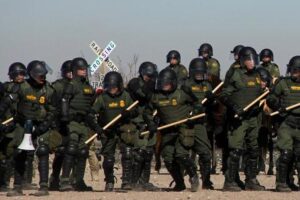The Trump regime’s mobilization of the U.S. Marines and National Guard to the streets of Los Angeles represents a dangerous escalation in Trump’s plans to impose his authoritarian rule.
Trump’s portrayal of the nation’s second largest city as a hellscape overrun by violent mobs is a figment of his fevered imagination. Department of Homeland Security (DHS) Secretary Kristi Noem bluntly declared that LA isn’t a city of “immigrants,” but a city of “criminals.” Trump claimed he was forced to send in the California National Guard over the objections of Governor Gavin Newsom and LA Mayor Karen Bass (both Democrats) because they refused to use the armed force necessary to quell the protests. Trump’s far right aide Stephen Miller claimed that the California Democrats were “siding with insurrectionist mobs,”
Trump even credited the National Guard with restoring the “peace” in LA—hours before the first soldiers arrived there—proving that calling in the military was completely unnecessary against the largely peaceful protesters. Anyone viewing the live video footage could easily see that ordering peaceful demonstrators to “disperse” and sending in police in riot gear against them provoked the violence, not the other way around.
The point wasn’t the reality of the situation. It was the pretext Trump wanted to deploy the military to act as his domestic enforcers.
Claiming that rioting has overtaken LA has offered Trump the excuse, however flimsy, to launch an authoritarian power grab to put military on the streets. The proclamation Trump issued did not even mention Los Angeles or California. In other words, Trump’s target is the entire country. Texas governor Greg Abbott followed suit, announcing he was deploying 5,000 National Guard troops and 2,000 additional Texas Department of Public Safety troopers across the state—before expected protests against federal deportation raids.
And Los Angeles is only the first time Trump has sent in the military against protesters exercising their constitutional right to free speech. Trump administration officials have made quite clear that other cities, especially those with with elected Democratic Party officials, are in their sights.
As if to demonstrate that the Trump administration inching toward a police state, multiple armed FBI agents manhandled Calif. Senator Alex Padilla at a press conference held by Noem before pushing him to the ground and placing him in handcuffs. DHS officials claimed they thought Padilla was an “attacker”—even though Padilla clearly identified himself as a US senator, as this video shows. Afterward, Padilla argued, “If this is how the Department of Homeland Security responds to a senator with a question, you can only imagine what they’re doing to farmworkers, to cooks, to day laborers out in the Los Angeles community, throughout California, and throughout the country.”
Whose violence?
Part of Trump’s aim in sending the military to LA was to portray the protesters as lawless “rioters”, thereby shifting the narrative away from ICE attacking harmless migrants and instead on allegations that demonstrators attacked police.
The corporate media was happy to comply. After the National Guard moved in, the New York Times reported on “clashes” between law enforcement and protesters, strongly implying that the protesters caused the violence: “Yesterday, hundreds of National Guard troops arrived in the city, and crowds of people demonstrated against President Trump’s immigration raids. They clashed with federal agents, leaving burned cars, broken barricades and graffiti scrawled across government buildings downtown.”
Fairness and Accuracy in Reporting (FAIR) described, “To CNN, protesters devolve into “violence,” while heavily armed agents of the state respond with “force.”
The authorities will toss charges of “violence” and warnings about “troublemakers” against anyone who tries to organize against their plans to invade communities and to round up working people. ICE arrested California president of the Service Employees International Union (SEIU) David Huerta and charged him with a felony of conspiracy to impede a federal officer because Huerta was observing and protesting ICE roundups. He was eventually released on $50,000 bond but still faces felony charges.
Among those joining the chorus condemning protesters is a full array of Democratic Party politicians who have done next to nothing to stand up to Trump.
We should recall that Democratic administrations under Clinton, Obama and Biden built the “border security” and deportation machine that Trump is now super-charging. In 2024, Kamala Harris campaigned for president on her bona fides as a “border state” prosecutor who would crack down on drug cartels and illegal immigration. Rather than offering an alternative to Trump and Trumpism, Harris and the Democrats simply amplified Trump’s anti-immigration rhetoric.
ICE agents are the actual “invaders”
Trump and his minions say that they are acting to stave off an “invasion” by “illegal aliens” and “criminals” flowing into the US. South Dakota senator Kevin Cramer stated explicitly, “Helping deter violence, especially from foreign invaders, fits [the National Guard’s] mission perfectly.”
But the real invasion is Trump’s unleashing of masked Immigration and Customs Enforcement (ICE) agents to terrorize immigrant communities around the country.
Miller in particular should be held responsible for the escalation of ICE raids that provoked the LA protests. Miller, who is known for haranguing and berating his MAGA underlings, apparently threatened ICE and DHS personnel with firing if they did not drastically increase the number of detained migrants to 3,000 daily. As the Independent reported,
Federal law enforcement officers needed to “just go out there and arrest illegal aliens,” Miller told top ICE officials, according to [the Wall Street Journal], citing people familiar with the meeting.
Rather than develop a list of targets for arrest, Miller told agents to raid Home Depot parking lots and 7-Eleven convenience stores, the newspaper reported.
Miller “eviscerated everyone,” according to recent reporting from The Washington Examiner. “‘You guys aren’t doing a good job. You’re horrible leaders,’” Miller reportedly said.
“He just ripped into everybody. He had nothing positive to say about anybody, shot morale down,” an official told the outlet.
… Days later, on June 6, ICE agents descended on a Home Depot in the predominantly Latino Westlake neighborhood of Los Angeles — kicking off a weekend of protests centered around a federal detention center in the city’s downtown and in the nearby Paramount and Compton neighborhoods.
With such blanket directives—and quotas to fulfill—the ICE agents, often with DHS and police backup, began conducting raids across the country, wherever they are likely to find the largest number of migrants: immigration courts and offices, workplaces, schools and churches. As it sweeps through migrant communities, ICE has very publicly contradicted its claim that it only targets “the worst of the worst” and “violent criminals.” In recent weeks, groups of agents have surrounded, handcuffed and detained scores of hard working and law-abiding migrants, including many who are in the US legally, before being “disappeared” to an unnamed detention center.
Moreover, the targets for deportation under Trump have shifted from those crossing into the US over the southern border (which have slowed dramatically) to detaining those who already have roots in communities, with jobs, schools, extended families and lives inside the US. As the Boston Globe reported on May 21, “Though the overall number of detentions is no different than under the previous administration, the number of people arrested within local communities has significantly ramped up under President Trump, with roughly 18,000 book-ins of people living in the country (as opposed to entering the border) in April compared to about 8,000 in December.” If Trump has his way, that number will continue to rise.
Resistance is growing
While the intent of these raids is to keep migrant communities cowering in fear, the response, by necessity, has been organized resistance. Emergency response networks have allowed neighborhood immigrants’ rights groups to use social media to alert and mobilize community members to oppose ICE raids and detentions.
For example, Marcelo Gomes da Silva, an 18-year-old Milford, Massachusetts, high school junior, was driving to volleyball practice in his father’s car when ICE pulled him over on May 31. They detained Marcelo when they discovered that his student visa had expired. He had not been notified that it needed to be renewed. “I was seven years old,” he explained.
The response from Marcelo’s classmates, teachers and community was immediate. Students walked out and rallied in his support the entire week; over a thousand students, teachers and other supporters marched through Milford with signs demanding Marcelo’s release. The class of 2025 joined the protest, still wearing their caps and gowns. The Massachusetts Teachers Association (MTA) also joined in. Supporters raised $2,000 so that he would be released on bond, which a judge granted after Marcelo spent six days in detention.
Acts of resistance have taken place in communities across the country in recent weeks—along with small victories like Marcelo’s. They have brought widespread attention to the brutality of ICE agents and exposed that most of the migrants being rounded up are valued members of their communities, not hardened gang members.
Describing the conditions he faced in detention, Marcelo told CBS News, “That place, it’s not good. It’s not good. Ever since I got here, they had me in handcuffs.” He also said that “he had not showered in six days, had crackers for lunch and dinner, slept on a concrete floor with a metallic blanket and had to use the bathroom in front of 40 other men.”
“Nobody should be in here,” Gomes da Silva said. “Most people in there are all workers. They all got caught going to work. These people have families.”
Community resistance in LA is also what really got Trump, Noem and the rest of the would-be dictator’s retinue worked up. ICE was initially defeated at the hands of ordinary workers and immigrants’ rights defenders who held them off for hours after the ICE goons tried to arrest day laborers at a Home Depot in Paramount, California.
But Trump has overreached, and public support for his mass deportations has plummeted as the resistance grows. For example, a Quinnipiac University poll conducted between June 5 and June 9 (covering part of the time after Trump called in the National Guard against LA protesters), showed 56 percent disapproving of Trump’s handling of deportations, with just 40 percent approving. Likewise, when asked whether all those born in the U.S. should be granted automatic (i.e., “birthright”) citizenship, 64 percent said birthright citizenship should continue, while 33 percent said it should not continue. Even more starkly, when asked whether international students coming to study in the U.S. is a “good” or “bad thing”, 74 percent said it was a “good thing,” and only 17 percent said it was a “bad thing.”
Not surprisingly, solidarity protesters took to the streets in many cities in the days following Trump’s deployment of the military to LA. These are the reasons why resistance must continue to grow, with both large-scale protests and local grassroots emergency response networks that can bring activists out at a moment’s notice.
“No Kings Day”
Millions of people took to the streets in 2,000 locations across the US on June 14 in what was dubbed “No King’s Day” by its coalition of organizers, together known as 50501, which stands for “50 protests, 50 states, one day.” Formed in February, 50501 emphasizes the need for united protests on a single day of action. It chose June 14 because on that date Trump spent between $25 and $45 million of taxpayer dollars (while slashing social spending) on a military parade in Washington, DC for his 79th birthday—which happened to coincide with the Army’s 250th anniversary.
True, Trump has never personally served in the military (he avoided Vietnam when a Queens podiatrist diagnosed him with bones spurs in the heels of his feet in 1968, allegedly as a favor to his father, Fred Trump). Nevertheless, he seeks to remind the world at every opportunity that he is now the Commander-in-Chief of the U.S. armed forces. The parade featured tanks, troops and hovering military aircraft—and ended with a celebratory jump by the Army’s Golden Knights parachute team, which presented a flag to Trump.
Millions of people joined in the protests on June 14th in defiance of Trump’s latest authoritarian power grab, with the largest drawing up to 100,000 demonstrators. A sea of people—most carrying handmade signs—swarmed downtowns in major cities. Many described their opposition to mass deportations as a key motivation to take part.
Contrary to Trump’s depiction of “violent protesters,” No King’s Day was overwhelmingly peaceful.
This is a perilous time. But Trump’s attempt to turn the U.S. into an authoritarian state is not inevitable. We now have an opportunity to build on the renewed momentum to strengthen popular willingness to defy Trump. The rise in struggle and the solidarity it produces are crucial to protecting our communities and all working people, no matter where they were born.




